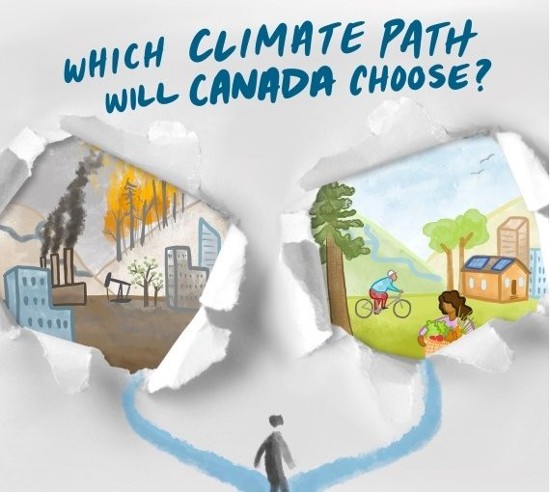At an all-candidates meeting held in my Toronto riding last week, the subject was climate change. The candidate for the Conservatives, one of the two political parties most likely to form the government, was a no-show.
When I was a younger man it was conservatives who took conservation seriously. The two words are derived from the same root verb “to conserve.” It was a conservative U.S. President that established the Environmental Protection Agency. It was through two conservative U.S. administrations that the disappearing ozone layer and acid rain were identified as human-caused and actions were taken to begin to address these environmental challenges. It was a U.S. president, along with Canada, who developed the notion of cap and trade to combat air pollution. Today, a number of countries, including China, and the European Union, as well as California and a number of other U.S. states, Quebec, and British Columbia, have all adopted this strategy to combat greenhouse gas (GHG) emissions.
Having said all that, the Conservative candidate missing in action last week, and apparently other candidates of that political stripe no-shows at similar cross-country events, said a lot about how far conservatism has strayed from conservation.
At the recent national Conservative Party Policy convention, the majority of delegates voted against a resolution recognizing that climate change was human-caused. Yet, the Party has put together what it hopes Canadian voters will see as a credible response to the existential threat of a warming planet.
As I have done previously in reviewing the Liberal Party platform, the following describes the Conservative Party’s policy planks followed by my rating on each and why my conclusions.
Conservative Party’s Climate Plan
- Pricing carbon pollution which the leader of the Conservatives has stated will start at $20 and not exceed $50 per metric ton of carbon dioxide produced by emitters and included in the price of products such as gasoline and diesel fuels. But the caveat is that carbon pricing must reflect an integrated North American approach and will be dependent on current provincial policies on carbon pricing, and the adoption of it by the federal government in the U.S. Rating F: Why? The current carbon price is $40 per ton in Canada or the equivalent through provincial programs. The Conservatives, therefore, would reverse the course of the current pricing policy which includes escalating the cost of carbon to a peak of $170 by 2030. Further, the conditional statement on actions dependent on what provinces and the U.S. do demonstrates a lack of leadership in combatting what the recent IPCC report describes as a “code red” for humanity and the planet.
- Introducing low-carbon savings accounts for Canadians to receive the full amount of money collected through carbon pricing each time they purchase hydrocarbon-based fuels. The offer will be made to small businesses as well. The money that would directly go into Canadian bank accounts could be used for purchasing “green” products and services such as transit passes, a bicycle, energy-efficient furnaces and windows, or an electric vehicle. Rating C: The idea sounds terrific but how does it inhibit the use of fossil fuels? Doesn’t it reward people for gassing up more often? How would you define and certify approved “green” products and services? And how is this an improvement over the tax rebate that currently goes to Canadians from the current carbon pricing policy?
- Introducing a zero-emission vehicle mandate targeting 2030 as the date when 30% of all light-duty vehicles sold in the country be electric, or hydrogen-powered. The policy would also require federal government properties to include charging station facilities by 2025 and a billion-dollar investment into domestic production of electric vehicles, battery technology, and transmission infrastructure to support the transition to zero-emission transportation. Rating B: The Conservatives are reflecting the policies adopted by the British Columbia government in incorporating this into their overall plan. It would have promising potential for developing a strong domestic industry. What I would have liked to see was more than a billion to go into zero-emission infrastructure and transportation improvements through grants and cash prizes awarded to Canadian innovators. But maybe that could happen under this policy.
- Meeting a 30% decrease in GHG emissions by 2030 and assessing the country’s progress after two years about setting industrial carbon prices on the path to $170 a ton by the same year. Rating F: This is a rollback to a position taken by the last Conservative federal government prior to 2015 and is out-of-step with the U.S. and the European Union. The rationale is “we aren’t going to change the rules just for the sake of change.” But global warming is accelerating and suggesting that tackling emissions makes Canada a less safe place to invest and create jobs is somewhat absurd.
- Reducing carbon emissions from every litre of gasoline and other liquid fossil fuels. This is setting a goal for producers to decrease emissions during the production of fuels by 20% per barrel. Rating E: The oil sands producers and the western provinces where much of our domestic oil and natural gas comes from have championed intensification per barrel as a strategy equivalent to overall emissions reductions yet have increased production volumes that leave us with net increases in overall emissions. So although it is useful to reduce emissions per barrel, if you continue to up the volume of barrels produced you achieve no environmental net benefit.
- Introducing a tax credit for rapidly accelerating the deployment of carbon capture, utilization and storage technology (CCUS) by 2030. The Conservatives claim in this policy plank that the Liberals do not support CCUS, yet Canada has two significant facilities already in operation and has cost-shared with provincial governments and industrial partners on such facilities. The policy also mentions partnering with Direct Air Capture (DAC) technology companies. Rating C-: CCUS and DAC are included in the latest IPCC climate assessment report as necessary to draw down existing carbon within the atmosphere. But to date, numerous projects of this type have failed because of energy companies backing out even after governments have put money into them. It would be important to know that tax credits came with some rules that would ensure Canadian taxpayers weren’t being defrauded when these projects go belly up.
- Investing $3 billion by 2030 in natural climate solutions including reforestation, grazing and grassland restoration, and wetlands to help sequester carbon, and involving Indigenous communities as guardians and stewards. Rating C-: The amount of money expended between now and 2030 is insufficient to make a negative impact on emissions without looking at current forestry and land management practices.
- Insisting on carbon border tariffs to be applied to imports from countries like China that are large polluters. Rating C-: Measuring the carbon content of every product imported into Canada requires the cooperation of companies and the countries where their operations are located. The European Union is the first jurisdiction to experiment with this type of tariff, and the U.S. is considering it as well. It would work if there was widespread agreement on how this will be measured, what the tariff will be, and who will actually pay it (the importer or the exporter).
- Improving building efficiency to reduce emissions by introducing a regulatory and financial framework to facilitate Energy Savings Performance Contracting with the private sector financing and implementing retrofits with payback through energy savings. The target date is to have this in place by 2030. It will also involve the creation of a Net Zero Foundation to revise building codes, develop curriculum for trades, and pilot new construction technologies. Rating C-: Why wait until 2030 when you can begin doing this now? This is aspirational and needs dollars applied to the programs envisioned.
The Conservative climate change policy book also includes a National Clean Energy Strategy. It includes:
- Strengthening the national electrical grid while deploying mass storage, new clean energy technologies, nuclear, hydrogen and renewables.
- Creating leadership in the application of ESG (environmental, societal, and governance) principles to capital markets and investments including the oil and gas sector to support emission intensity reduction advances.
- Building a Hydrogen infrastructure using both blue and green sources.
- Ensuring Canada develops its liquid natural gas (LNG) capacity to export to world markets and to use as an important internal transitional fuel to replace coal in thermal power plants.
Rating on the National Clean Energy Strategy D: I would have considered a C if not for the inclusion of LNG as a transitional fuel, and the application of ESG principles to the oil and gas sector. ESG principles are to “do no harm.” How does this equate when talking about GHG emissions largely produced by the burning of fossil fuels? And we are past the use of the transitional fuel arguments related to natural gas, liquefied or not. That may have flown during the early Harper years and when Obama was President in the U.S., but the “code red” status of global climate has even the International Energy Agency (IEA), the global body that represents and supports the energy industry, stating we no longer can be developing fossil fuel resources.
Overall, my rating for the Conservative platform on climate change policy is an E. Why? Because on the important policy points this plan scores Fs. F on reversing carbon pricing, and F on decreasing emissions far less than the target set by the alternative Liberal plan. We can’t afford to be less aggressive when the IPCC report tells us that atmospheric warming and other global climate change impacts are accelerating and costing both lives and tens of billions of dollars annually to deal with trying to keep the status quo. And then to support a false notion that fossil fuel intensity targets can substitute for capping production and beginning to reduce it incrementally is unconscionable.
















